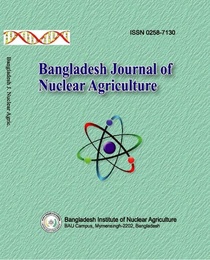FRUIT DIVERSITY OF TEN MANGO (Mangifera indica L.) GERMPLASM OF CHAPAINAWABGANJ DISTRICT IN BANGLADESH
Abstract
An experiment was conducted to study ten mango (Mangifera indica L.) germplasm during July 2018 to May 2019 in Shibganj, Chapainawabganj. Fruit characteristics varied greatly among the studied mango germplasm. The germplasm, Fazli was the largest fruit (Length 14.47 cm, Breadth 8.40 cm, Thickness 7.80 cm) having maximum fruit weight 743.33 g and the highest pulp quantity 614.67 g with highest pulp/peel & stone ratio (4.80) among the germplasm. Ripen mango contained the highest TSS (°Brix) in the germplasm Langra (20.67%) which was better than Fazli. The largest stone was recorded in Fazli (Length 11.60 cm, Breadth 4.87 cm, Thickness 2.70 cm) having maximum weight 66 g whereas minimum in Khirsapat 39.13 g among the germplasm. From biplot analysis it was recorded that there was a positive correlation between fruit weight and pulp weight in the germplasm Fazli. From genetic diversity analysis it was revealed that Fazli had higher genetic similarity and Ashina had lower genetic similarity with another germplasm. The dendrogram generated from the unweighted pair group arithmetic average (UPGMA) cluster analysis broadly placed 10 mango cultivars into four major clusters. The cluster size varied from 1 to 5. Cluster I was the largest cluster comprising of five germplasm. The tendency of clustering among mango cultivars revealed that they have strong affinity towards further breeding program.
References
Barua, H., Patwary, M.A., and Rahman, M.H. 2013. Performance of BARI mango (Mangifera indica L.) varieties in Chittagong region. Bangladesh j. agric. res. 38(2): 203-209.
BBS (Bangladesh Bureau of Statistics), 2020. Year Book of Agricultural Statistics of Bangladesh. Statistics Division, Ministry of Planning, Government of the People’s Republic of Bangladesh. pp. 197-201.
Bhuyan, M.A.J. and Islam, M.S. 1989. Physio-morphological characters of some popular Mango cultivars in Bangladesh. Bangladesh j. agric. res. 17(2): 19-27.
Bureau, S. 2009. The use of non-destructive methods to analyse fruit quality. Fresh prod. j. 3:23-34.
Candole, A.D. 1984. Origin of Cultivated Plants. Vegal Paul Trench and Company, London. pp. 1-67.
Chapman, E. and Smith, J.A. 2002. Interpretative phenomenological analysis and the new genetics. J. Health Psychol. 7(2): 125-130.
Elsheshetawy, H.E., Mossad, A., Elhelew, W.K. and Farina, V. 2016. Comparative study on the quality characteristics of some Egyptian mango cultivars used for food processing. Ann. Agric. Sci. 61(1): 49-56.
Farshadfar, E., Poursiahbidi, M.M. and Safavi, S.M. 2013. Assessment of drought tolerance in land races of bread wheat based on resistance/tolerance indices. Int. j. adv. biol. Biomed. Res. 1(2): 143-158.
Gomez, K.A. and Gomez, A.A. 1984. In: Statistical procedures for agricultural research. John Wiley & Sons.
IPGRI, 2006. In: Descriptors for Mango (Mangifera indica L.). International Plant Genetic Resources Institute, Rome, Italy. pp. 1-71.
Iyre, C.P.A. 1991. Recent Advance in varietal improvement in mango. Acta Hortic. 291. pp. 32-109.
Jacobi, K.K., MacRae, E.A. and Hetherington, S.E. 2001. Postharvest heat disinfestation treatments of mango fruit. Sci. Hortic. 89(3): 171-193.
Majumder, D.A.N., Hassan, L., Rahim, M.A. and Kabir, M.A. 2011. Studies on physio-morphology, floral biology and fruit characteristics of mango. J. Bangladesh Agric. Univ. 9(452-2016-35431).
Molla, M.R., Ahmed, I., Hossain, M.A., Islam, M.S., Chowdhury, M.A.Z., Shabnam, D. and Rohman, M.M. 2019. Morphological characterization and Simple Sequence Repeats (SSRs) based DNA fingerprinting of selected mango (Mangifera indica L.) genotypes in Bangladesh. J. Hortic. For. 11(7): 104-119.
Rahman, M. 2016. In: Morpho-molecular characterization of sixty local mango germplasm of Chapainawabganj. An MS Thesis, Department of Horticulture, Bangladesh Agricultural University, Mymensingh. pp. 20-105.
Saini, S.S., Singh, R.N. and Pauwal, G.S. 1971. Growth and development of mango (Mangifera indica L.) fruit I. Morphology and cell division. Indian J. Hortic. 28(4): 247-256.
Yan, W. and Reid, F.J. 2008. Breeding line selection based on multiple traits. Crop Sci. 48(2): 417-423.
-
Download



